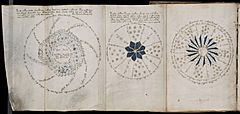Constructed language facts for kids

An artificial or constructed language (sometimes called a conlang) is a language that has been created by a person or small group, instead of being formed naturally as part of a culture. Some constructed languages are designed for use in human communication (like the common Esperanto). Others are created for use in fiction, linguistic experiments, secret codes, or simply because the maker likes to play language games.
Constructed languages can be split into a priori languages, which are made from scratch, and a posteriori languages, which borrow words and grammar from existing languages.
Constructed languages can also be split into groups by purpose. These groups are:
- Engineered languages (engelangs), which are split into philosophical languages and logical languages (loglangs) - designed for experiments in logic or philosophy
- Auxiliary languages (auxlangs) - designed to be a lingua franca for international communication (also called International Auxiliary Language, (IAL))
- Artistic languages (artlangs) - designed to look or sound pretty, or just for fun.
Some constructed languages also have constructed scripts to write them.
Some examples of constructed languages
- American Sign Language, as well was other signed languages for the deaf
- Basic English
- Na'vi language
- Brithenig
- Dothraki
- Dovahzul
- Dutton's Speedwords
- Esperanto
- Glosa
- Huttese
- Ido
- Interlingua
- Klingon
- Láadan
- Latino Sine Flexione
- Lingua Franca Nova
- Lojban
- Middle-earth languages (Quenya, Sindarin)
- Newspeak
- Novial
- Occidental (Interlingue)
- Pig Latin
- Quenya
- Simlish
- Sindarin
- Solresol
- Toki Pona
- Volapük
- Wenedyk
See also
 In Spanish: Lengua construida para niños
In Spanish: Lengua construida para niños

